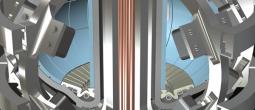

Chief Petty Officer (CPO) Sonya Akakios is a helm specialist (known as a quartermaster) and is a member of the navigation branch.
Akakios is responsible for vessel maneuvering using the helm. She works closely with tactical and science teams to ensure optimal vessel orientation for defence and exploration.
What Would I be Doing?
Interested in Sonya’s role as quartermaster?
Once you've completed training at the Academy you'll be able to gain more experience by joining simulator missions chosen from a growing library of tactical, exploratory, scientific and diplomatic scenarios.
As quartermaster you’ll be responsible for making sure the ship gets to where it needs to be (or away from where it doesn’t). A starship can operate in three navigation modes, although most vessel maneuvering is done in impulse (sublight) mode.
Impulse Navigation Mode
In impulse mode the vessel operates at sublight speeds, up to 0.2C (60,000km/sec). These speeds are sufficient to navigate between planets within a stellar system.
Most tactical operations occur in this mode, including the tracking of other vessels and combat. During tracking the quartermaster works with EMDAR specialists to assist with locating targets by setting up search patterns and reorienting the vessel to help narrow down search results.
During combat the quartermaster works with Weapons Direction specialists to ensure the vessel reaches optimal conditions for weapons launch.
Should the vessel come under fire, the quartermaster must attempt to evade or orient the vessel to minimise damage.
At all times the quartermaster must also be aware that the vessel’s main engines are its largest source of EM emissions, which can give away the vessel's position.
FTL Navigation Mode
This navigation mode is used to travel between stellar systems using Faster-Than-Light (FTL) relativistic speeds. This is a point-to-point mode of travel, as no maneuvering is possible while underway at FTL. Other vessels in surrounding space cannot be detected and are unlikely to be able to detect an FTL vessel.
RCS Navigation Mode
In this navigation mode the vessel operates at extremely slow speeds - hundreds or thousands of km/h, depending on the context. The vessel’s Reaction Control System (RCS) is used to perform precise maneuvers for applications such as rendezvous, station-keeping or orbital insertion.
Becoming a Quartermaster
As a crew specialist you’ll be aiming for mastery of your chosen ship system, gaining extensive mission experience.
First Steps
It starts by signing up as crew. It's obligation free and provides access to more information about the mission and Endeavour's technology as well as access to the Academy and assistance from the ISDC team.
You’ll be asked to choose a ship system that interests you and begin training. As an aspiring quartermaster you’d likely choose a key course such as impulse operations.
When you successfully complete a training course you’ll be qualified (or ‘rated’) to operate that system on missions. You’ll also be promoted to the rank of qualified crew.
Once you’re rated, you’ll be able to join mission simulations to gain practical experience.
Gaining Experience
As you participate in missions your experience will be logged and will contribute to your next step up in rank.
As you reach more senior ranks you’ll have option to pass on some of your experience as an instructor or to contribute directly to the development of your system.
Not Sure?
Choosing your first rating doesn’t lock you into any particular career track or role. Choose something that interests you so that you can try simulator missions and get a feel for what you enjoy most.
There are no barriers to changing career tracks at any time. Your accumulated experience and ratings are fully transferable.









